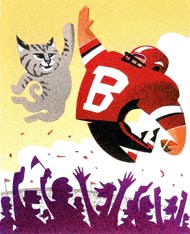A Bobcat for the Ages
Imagine a huge neon depiction of founder Oren Cheney on the side of Pettengill Hall, topped with 10-foot flashing maroon letters spelling Amore ac Studio. What would most alarm you about this public-art scenario? The garish result, or whatever loopy process, or lack thereof, that led to its installation?

A Bobcat statue could be a Bates rallying point where the bold visual message is "We are Bates."
Because public art is a magnet for anger, you have to invite everyone to the party early and follow a clear process together,” says Mark Bessire, director of the Bates College Museum of Art and chair of the College’s recently formed Public Art Committee.
Of course, no one has suggested such a gaudy garnet structure at Bates, least of all the Class of 2004. Their Senior Gift was devoted to creating a more appropriate monument: a regal statue of a Bates Bobcat.
In 2004, the class moved with dispatch to get a statue designed and installed, raising $27,000 (subsequent fundraising and interest earnings have brought the fund to $43,000). But while accepting the gift, College officials also realized Bates had no guidelines for evaluating, accepting, and installing any kind of public art — permanent or temporary, from memorial gardens to electronic media. So the project was put on hold.
The class did a commendable job,” says Bessire. “And it forced Bates to create a public art process.”
Now that Bates has a Public Art Committee, backed by 10 pages of policy very similar to guidelines found in most cities, the Bobcat statue project is making tracks. A committee of staff, faculty, and alums Mike Lopez ’04 and Alex Strekel ’04, who co-chaired the fundraising effort in 2004, is in place.
We’re pleased to be at this point,” says a gracious Strekel.
In the spring, the project committee proposed the project to the Public Art Committee, which responded with basic questions: What are the proposed size, material, and site?
With the Bates athletics enterprise now concentrated mostly around Merrill Gym, the project committee will likely recommend a site near the Merrill entrance. The statue will likely be bronze and life-size, perhaps mounted on a pedestal to offset the fact that an average bobcat is just 3 feet long and 15 inches tall at the shoulders. The next step this winter will be to provide details about the project to the campus community and invite discussion, says Bessire. Then would come the selection of an artist. Although a bulletproof process is no promise of success, in the end “good art silences critics,” he adds.
In part, the Class of ’04 leaders chose the Bobcat project because they saw a gap — mascot statues at Bowdoin, Colby, and Middlebury were established in 1937, 1995, and 1997, respectively. But they also wanted a permanent totem of Bates sports, says Strekel, a Bobcat rallying point where the bold visual message is “We are Bates.”